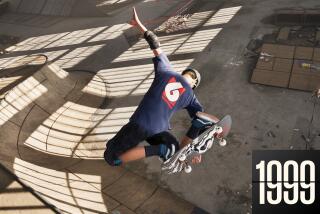First ‘Jet Grind,’ Then Juvenile Hall
- Share via
This is a warning to parents with kids who own a Sega Dreamcast: Do not buy “Jet Grind Radio” for your children. And don’t let your kids buy it on their own. In other words, keep them as far away as possible from a game that promotes just the sort of mayhem that makes urban life so unpleasant.
“Jet Grind Radio” is a game about in-line skating. And graffiti tagging. And running from the cops. And staking your claim to turf coveted by rival gangs. Not to put too fine a point on it, but “Jet Grind Radio” is all about the sort of thuggery most parents pray their children never fall into.
Of course, designers liven up the game with colorful imagery, compelling music and comical cops who look as if they’re straight out of some futuristic Keystone caper. But the bottom line is that “Jet Grind Radio” is one of the most irresponsible games ever put out for a set-top console.
Now, all this may sound strange coming from someone who rejects the argument that violent video games create violent kids. Playing “Doom” does not turn a kid into the sort of psychotic who takes a gun to school and blows away his classmates. Those kids are profoundly disturbed--and they didn’t get that way playing the same video game that millions of normal people play every day.
But “Jet Grind Radio” is different. It’s not about blasting aliens on some far-off galactic colony. It’s about things that kids experience and confront every day. And it turns them in exactly the wrong direction.
The game begins with three tagging crews vying for control of Tokyo-to, a “city in Asia similar to Tokyo.” The crews scoot from place to place on supercharged in-line skates. As the game unfolds, players find spots ripe for defacing, and they score points by spray-painting either the tag of their crew or a custom-designed piece of graffiti. All of this must be done while avoiding the cops, who punish the taggers with billy clubs and guns.
So within minutes of starting “Jet Grind Radio,” a player learns that, yes, it’s OK to use public property as a skate jump and that, yes, it’s cool to spray-paint buses, walls and taxicabs and that, yes, the cops are evil people who should never be trusted. Of course, these are just the kinds of lessons most parents want their kids to learn at an early age. Not!
Sega tries to squirm out of this uncomfortable position by displaying two labels--one on the jewel case and another in the game itself--warning that “vandalism is a crime and punishable by law.” Given the context, it’s a little like saying: “Hey, kids, playing with fire is dangerous. But it sure is a lot of fun--and here’s a book of matches.”
Be smart: Stay away from “Jet Grind Radio.”
‘Cool Boarders 2001’
The cool thing about the “Cool Boarders” series is that they just keep getting better with each successive version. The fifth installment, “Cool Boarders 2001,” delivers snowboard action unlike anything else on Sony PlayStation. Yet compared with a next-generation title such as SSX for Sony PlayStation 2, “Cool Boarders 2001” looks and plays like something out of the Stone Age.
To be fair, that’s like comparing your trusty 5-year-old Mazda Miata with your neighbor’s brand-new Porsche Boxster. Yes, technically, they’re both two-seat roadsters, but in reality, they’re not even related. So it is with video game consoles.
Like all snowboard and skateboard games, “Cool Boarders 2001” depends heavily on players’ ability to perform tricks. It’s what keeps the game fresh and entertaining for longer than it takes to just scoot down all the tracks.
‘The Legend of Zelda: Majora’s Mask’
Nintendo is smarter than most companies at exploiting its franchises. Witness the success of Pokemon and, over a longer, more subdued run, Mario. Also in that bag is Link, the hero of the “Legend of Zelda” series, which debuted in 1986 on the 8-bit Nintendo Entertainment System. Nearly 15 years--and three system generations--later, Link is as enjoyable as ever.
In the second “Zelda” title for Nintendo 64, “Majora’s Mask,” players help Link save the world of Termina, which has three days until the moon falls from the sky. Although simple to play, “Majora’s Mask” is an incredibly complex game that offers significant challenges. Most of the challenges are timed, so players must move swiftly to uncover crucial information.
As with all “Zelda” games, “Majora’s Mask” depends on a text-based system of character interaction. Talk to a character, and the words appear in pop-up windows that players can scroll through. Players who enjoy a solid, good-natured adventure will enjoy “Majora’s Mask.”
*
Aaron Curtiss is editor of Tech Times.
(BEGIN TEXT OF INFOBOX / INFOGRAPHIC)
The Skinny
“Jet Grind Radio”
Genre: Juvenile delinquent simulator
Price: $50
Platform: Sega Dreamcast
Publisher: Sega
ESRB rating: Teen
The good: Great graphics, play
The bad: Sets a very bad example
Bottom line: Stay away
*
“The Legend of Zelda: Majora’s Mask”
Genre: Adventure
Price: $60
Platform: Nintendo 64
Publisher: Nintendo
ESRB rating: Everyone
The good: Huge adventure
The bad: Not much
Bottom line: A wonderful game
*
“Cool Boarders 2001”
Genre: Snowboarding
Price: $40
Platform: Sony PlayStation
Publisher: Sony Computer Entertainment
ESRB rating: Everyone
The good: Lots of challenge
The bad: Newer games look better
Bottom line: Very nice
*
*Entertainment Software Ratings Board
More to Read
The biggest entertainment stories
Get our big stories about Hollywood, film, television, music, arts, culture and more right in your inbox as soon as they publish.
You may occasionally receive promotional content from the Los Angeles Times.










